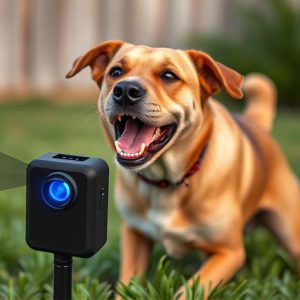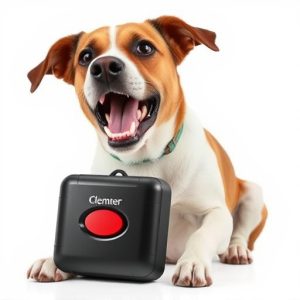Handheld Dog Deterrents: Training Tools for Positive Behavior Modification
Canine behavior, shaped by instincts, experiences, and environment, often exhibits unwanted traits l…….
Canine behavior, shaped by instincts, experiences, and environment, often exhibits unwanted traits like barking, aggression, or destructiveness driven by fear, anxiety, boredom, or lack of socialization. Handheld dog deterrent carrying methods, featuring ultrasonic bark deterrents, offer effective, non-harmful solutions. These devices emit high-frequency sounds (25-64 kHz) imperceptible to humans but disruptive to dogs, encouraging positive behavior through reinforcement. Validated by studies, these tools are preferred for humane behavior modification, with proper usage involving responsible carrying methods and regular maintenance to avoid stressing or harming pets while promoting holistic training alongside alternative techniques.
Unleash the power of positive change with our comprehensive guide to canine behavior modification using ultrasonic systems. Explore the intricate world of dog behavior, uncovering the roots of unwanted actions that often drive their choices. Delve into the science behind these innovative devices, understanding how they work and why they’re effective tools for trainers.
Learn about handheld dog deterrent devices, their design, safe use, and considerations for responsible carrying methods. Discover proven training techniques to foster positive behavior transformation in your canine companion.
- Understanding Canine Behavior: Uncovering the Roots of Unwanted Actions
- The Science Behind Ultrasonic Systems: How They Work and Their Effectiveness
- Handheld Dog Deterrent Devices: Design, Use, and Safety Considerations
- Training and Implementation: Effective Methods for Positive Change in Dogs
Understanding Canine Behavior: Uncovering the Roots of Unwanted Actions
Canine behavior is complex and multifaceted, shaped by a combination of innate instincts, past experiences, and current environments. To effectively modify unwanted behaviors, it’s crucial to understand their roots. Dogs, as social animals, communicate through a variety of signals—body language, vocalizations, and scent marking. Unwanted actions like excessive barking, aggression, or destructiveness often stem from fear, anxiety, boredom, or lack of socialization. For instance, a dog that barks excessively at passersby might be reacting to unfamiliar stimuli out of fear or territorial instinct.
Identifying the underlying cause is key when employing a handheld dog deterrent carrying method. These devices, such as ultrasonic bark deterrents, are designed to interrupt and discourage unwanted behaviors without causing harm. By understanding the behavior’s motivation, owners can use these tools responsibly and target specific issues. For example, an ultrasonic device can be effective in reducing excessive barking by emitting high-frequency sounds that disrupt the dog’s focus on the stimulus, thereby encouraging a calmer response.
The Science Behind Ultrasonic Systems: How They Work and Their Effectiveness
Ultrasonic systems, designed as canine behavior modification tools, employ high-frequency sound waves to communicate with dogs. These devices emit sounds beyond human hearing ranges, typically between 25 and 64 kHz. Dogs, however, are sensitive to these frequencies, perceiving them as either discomfort or a gentle reminder depending on the tone and intensity. The science behind their effectiveness lies in positive reinforcement: when a dog associates a specific ultrasonic sound with a desirable behavior, it learns to avoid the trigger (negative reinforcement) or repeat the desired action (positive reinforcement).
Handheld dog deterrent carrying methods incorporate these systems for easy deployment. Users can discreetly activate the devices when needed, making them ideal for training sessions or managing unwanted behaviors in various settings. The effectiveness of ultrasonic systems is supported by numerous studies showing their success in modifying canine behavior, especially regarding barking, aggression, and fear responses. Their non-invasive nature makes them a preferred choice for many pet owners looking to train their dogs without resorting to more traditional, potentially harsh methods.
Handheld Dog Deterrent Devices: Design, Use, and Safety Considerations
Handheld dog deterrent devices, often designed as ultrasonic systems, are convenient tools for canine behavior modification. These portable devices emit high-frequency sound waves that are inaudible to humans but can effectively deter dogs from unwanted behaviors like barking, jumping, or chewing. The design typically includes a handheld unit with a trigger mechanism, allowing users to activate the device when needed. Some models feature adjustable settings for different dog breeds and sensitivities, ensuring safe and effective use.
When using these devices, it’s crucial to consider proper handling and safety measures. Users should familiarize themselves with the carrying methods recommended by manufacturers, as incorrect usage might cause stress or even harm the animal. Regular maintenance and battery checks are essential to keep the device functioning optimally. Additionally, responsible owners should explore alternative training methods alongside ultrasonic deterrents for comprehensive behavior management.
Training and Implementation: Effective Methods for Positive Change in Dogs
Training and Implementation: Effective Methods for Positive Change in Dogs
When it comes to modifying canine behavior, especially in addressing unwanted actions, a range of positive reinforcement techniques proves highly effective. Handheld dog deterrents, such as ultrasonic systems, are innovative tools that utilize sound waves to discourage problematic behaviors without resorting to punishment. These devices are designed with ease-of-use in mind, often featuring simple activation methods like a trigger or remote control. By employing these carrying methods, owners can discretely and humanely guide their dogs towards better behavior.
The implementation process begins with setting clear goals and understanding the dog’s triggers. Consistent training sessions, incorporating positive reinforcement, teach the canine new behaviors while reinforcing desired actions. For ultrasonic deterrents, training involves exposing the dog to the device’s sound in a controlled environment, gradually increasing its sensitivity to the signal. With patience and persistence, dogs learn to associate the sound with a specific behavior, effectively modifying their response over time.
The integration of canine behavior modification through ultrasonic systems offers a promising approach to addressing unwanted behaviors. By understanding dog behavior and leveraging scientific principles, handheld dog deterrents have emerged as effective training tools. These devices, when used responsibly and in conjunction with positive reinforcement techniques, can foster better canine-human interactions. When selecting and employing these methods, considering the design, safety, and individual dog needs is paramount to ensure successful and humane behavior modification.


